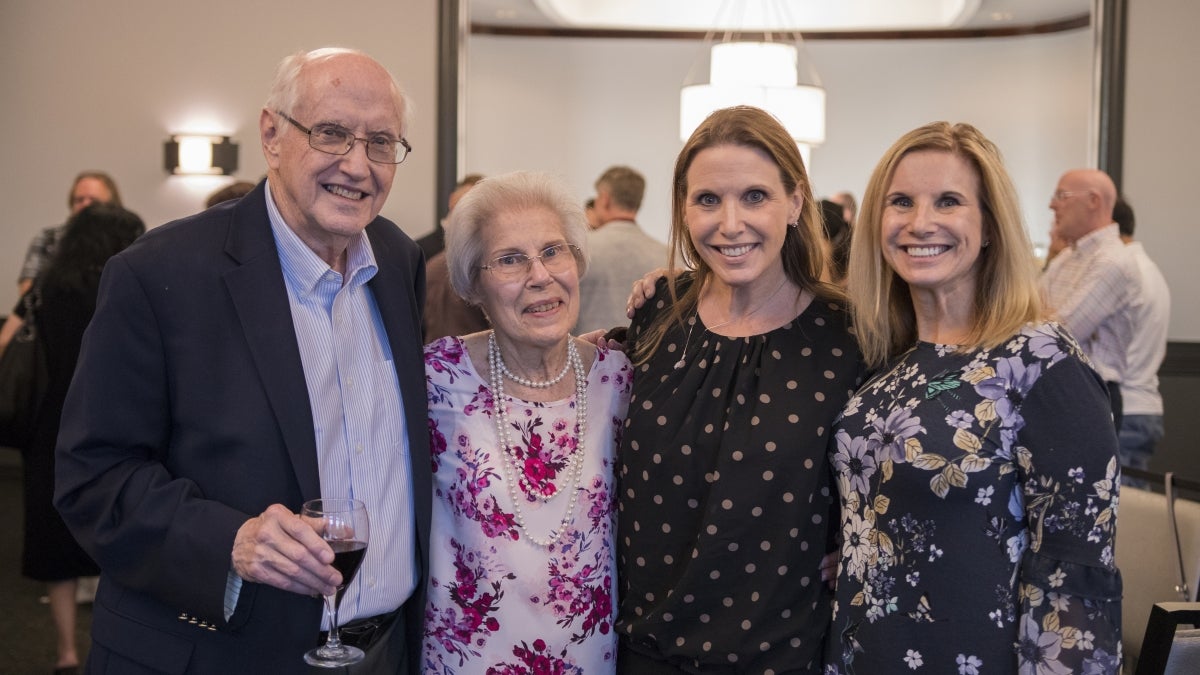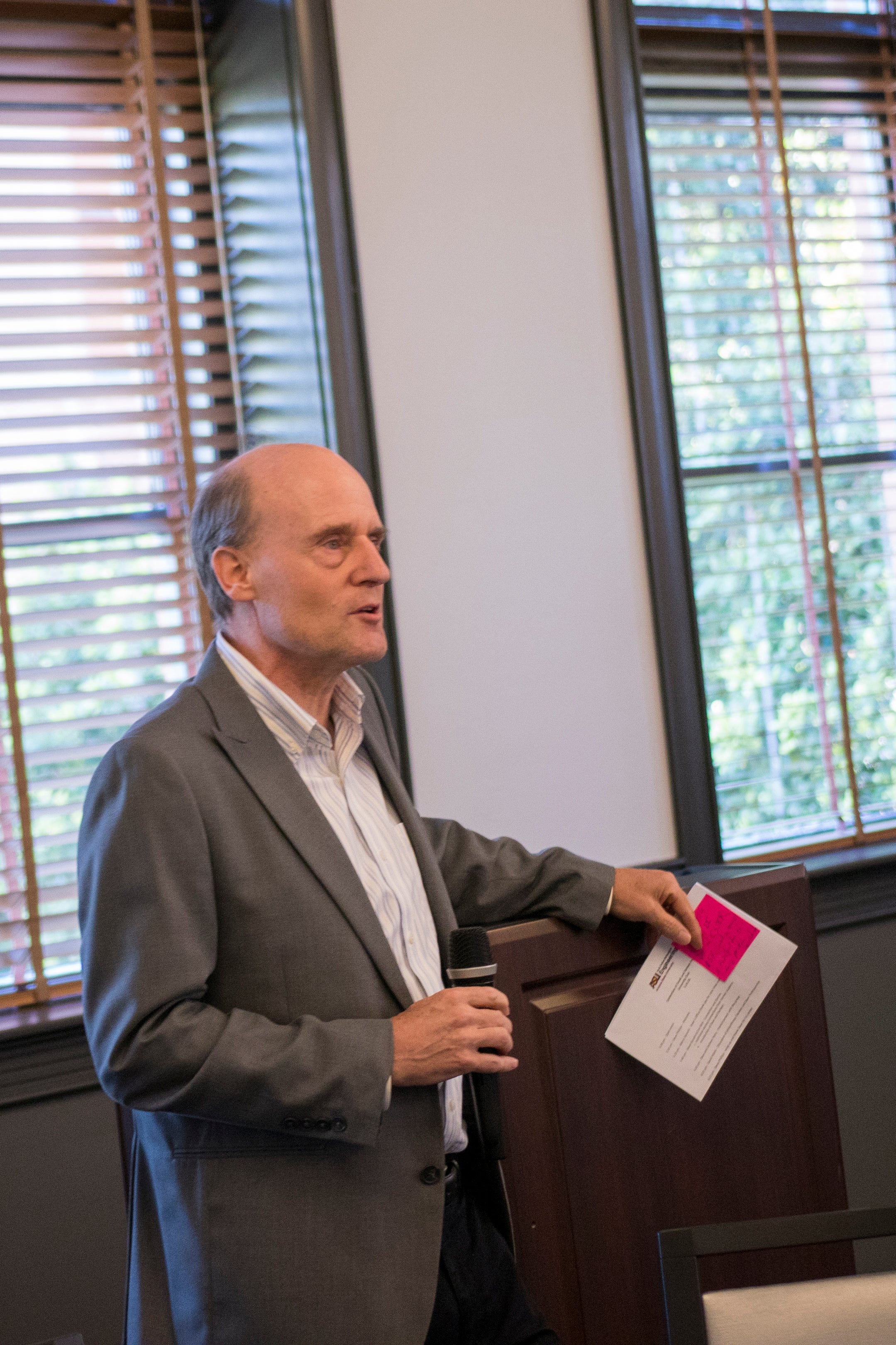Academic rigor, research quality define professor’s legacy

Ira A. Fulton Schools of Engineering Emeritus Professor David Ferry pictured (from left) with his wife, Darleen, and daughters Linda Parkis and Lara Ferry at a recent reception honoring him for his 35 years of teaching and research at Arizona State University. A gift to ASU from David and Darleen Ferry will fund a professorship to support advanced electrical engineering research at the university. Photo by Marco-Alexis Chaira/ASU
Thirty-five years after joining Arizona State University, David Ferry is making the transition to emeritus professor after his official retirement early this year. Ferry is acknowledged by his colleagues for a long list of contributions that have heightened the university’s academic and research stature and propelled students toward their career goals.
“Dave’s dedication and scholarship has not only been seminal to the field of physical electronics, but to advancing key components of the Fulton Schools research activities at ASU,” said Kyle Squires, dean of ASU’s Ira A. Fulton Schools of Engineering. “His leadership as an administrator, faculty member, researcher and mentor have been critical to our success and to countless PhD students who have worked directly with him.
"Simply put, we are a better institution owing to Dave’s impacts, and the genesis of much of our research prowess can be traced to his influence. It’s an incredible legacy.”
In the beginning
In the early 1980s, Charles Backus was charged with driving Arizona State University’s Engineering Excellence program — its primary directive was to up the quantity and quality of the engineering college’s research.
As the college’s associate dean for research at the time, BackusCharles "Chuck" Backus later became provost of ASU East, now the ASU Polytechnic campus. He retired in 2004. traveled to the nation’s capital to meet with leading funding agencies and research administrators to make them aware of the program’s aspirations.
When he told a manager at the Office of Naval Research he was looking for the best people to lead ASU’s effort, the manager had an immediate response: Hire Dave Ferry.
Ferry had been with the ONR from 1973 to 1977 before joining the electrical engineering faculty at Colorado State University. Backus lured him to ASU with the opportunity to play a big role in shaping the future of ASU’s ambitious engineering education and research endeavors.
“I guess he thought I could be a good leader or maybe inspire people,” Ferry said.
It turned out Backus thought right.
Ferry was soon appointed director of ASU’s new Center for Solid State Electronics Research (originally the Microelectronics Research Center). Backus recalls that Ferry “proceeded to build the center into a first-class organization that became truly respected around the world. He led that effort by his personal example of hard work and he expected the other professors in the center to do the same.”
At around that time, the Engineering Research Center on ASU’s Tempe campus was built. It featured “perhaps the best clean-room laboratory for microelectronics research of any university in the country,” Backus said.
With that state-of-the-art facility, “Dave was able to attract both experienced researchers and promising young engineers to join our faculty,” Backus said, and their combined efforts helped “to mark the start of ASU becoming the major research university it is today.”
From 1983 to 1989, Ferry was the first director of ASU’s Center for Solid State Electronics Research, and in that short time became highly regarded in that field. From 1989 to 1992, he was chair of the electrical engineering department before taking on the associate dean for research job from 1993 to 1995.
At the forefront of electrical engineering advances
Throughout the years, Ferry expanded his research repertoire across multiple complex explorations, mainly revolving around the quantum effects in submicron semiconductor devices and nanostructures and the general development of quantum transport in open systems.
Ferry has authored or co-authored more than 800 research papers, written or co-written 10 textbooks, 32 chapters in science books and 16 other books he describes as “quasi-scientific” (including “50 Years in the Semiconductor Underground” and the soon-to-be-published “The Copenhagen Conspiracy”). Collectively those writings have spanned a broad range of the many facets of electrical engineering, electronics and related physics and mathematics.
Colleagues laud Ferry in particular for being exceedingly proficient at both the experimental and theoretical aspects of his discipline and its practical applications.
Fulton Schools Professor Stephen Goodnick began collaborating on research with Ferry as a graduate student at Colorado State University.
By the time Ferry got to ASU, “it was the beginning of what we now call nanotechnology,” Goodnick said at Ferry’s retirement reception in May. "They didn’t even have the word nanotechnology at that time, but it was a time when people were just starting to create things at a scale that no one had seen before. Dave led an intellectual movement, along with several others, that was exploring what was going to happen with transistors when they got to the nanometer scale.”
Such accomplishments led Ferry to be named one of the first Regents’ Professors, the highest professional designation for faculty members at Arizona’s state universities, and to win the prestigious Cledo Brunetti Award from the Institute of Electrical and Electronic Engineers for advances in nanoelectronics.
Ferry also attained the top status of fellow in the IEEE and other professional organizations in electrical engineering and physics and served as the editor for major research journals in those fields.
A reception for David Ferry (fifth from left) brought together fellow faculty members from ASU and other leading universities, along with former students, to applaud Ferry’s wide range of accomplishments as a researcher and his valuable guidance as a teacher, mentor and colleague. Photo by Marco-Alexis Chaira/ASU
Creating opportunities for students to excel
His impact is equally reflected in his teaching. Ferry says he measures much of his career success by the achievements of his students.
The esteemed professor has guided 45 students through studies to earn doctoral degrees, and by his own count at least 12 former graduate students are on the faculties of top universities around the world and more than 40 have found prominent positions in industry. He also supervised about 25 postdoctoral and visiting researchers, several of whom also are leading faculty members at universities.
Ferry’s value to students went beyond his skills at classroom instruction and research guidance, said Gary Bernstein, who earned his doctoral degree under Ferry’s supervision and is now the Frank M. Freimann Professor of Electrical Engineering at the University of Notre Dame.
“I was fortunate to be working for and with someone who provided me with exceptional opportunities," Bernstein said. "Dave was always available to give advice and was very involved in the research. He seemed to be a bottomless pit of resources, from supplies to equipment, and especially conference travel.
“Dave always included his students in his conference activities, making sure that we all got to know, and be known by, his friends and colleagues, and funding agents,” Bernstein added. “I assumed that it was normal to travel as extensively as I did at that time, not realizing until I had my own academic career how difficult it is to keep the funds coming in to allow my students to grow professionally, as Dave did for me.”
Ravindra Joshi, a professor of electrical and computer engineering at Texas Tech University also conducted his doctoral studies and research under Ferry’s guidance. (Ferry, originally from San Antonio, earned his bachelor’s and master’s degrees at Texas Tech before getting a doctoral degree at the University of Texas at Austin.)
Joshi said Ferry “is one of the very few researchers and scientists I have known in over 30 years who has the ability to engage in meaningful, cutting-edge research in both the theoretical and experimental aspects.”
Joshi has always been impressed by Ferry’s ability to extract maximum value from the results of research experiments by “picking up subtle features from the data, tying those in with theoretical models and mechanistic hypotheses, and encouraging further analysis to probe and understand the underlying phenomena that might be at work.”
Ferry went the extra mile to organize workshops and mini-conferences that put students in contact with leading engineers and scientists who provided his students “lively forums for learning and the healthy exchange of ideas,” Joshi said.
Ferry encouraged his students to present their research at conferences and to submit papers to research publications.
“He probably never had a graduate student who did not publish at least one article in a research journal before they graduated,” Joshi said.
Colleagues describe determined, high-spirited personality
Ferry’s fierce commitment to his students’ progress can be seen in the way he engages with colleagues and peers as well as his students, said Jonathan Bird, a professor and chair of the electrical engineering department at the University of Buffalo who has known Ferry for more than 25 years. Bird traveled from New York to attend Ferry’s retirement reception.
“When you have a conversation about science with Dave, prepare for it to be emotionally brutal. He gives unvarnished truthful opinions, but only in the hope and desire that you will reach a solution to whatever problem you are working on,” Bird said. “He treats all people respectfully regardless of their status and position in life. He is just as likely to tell Nobel laureates they are wrong, as he is to correct young graduate students by giving them the direction they need.”
Ferry’s exuberant engagement in his work is confirmed by Karl Hess, a University of Illinois emeritus professor of electrical and computer engineering.
Hess met Ferry more than five decades ago when he was a graduate student at the University of Vienna in Austria, where Ferry was doing research at the Boltzmann Institute for Solid-State Physics through a National Science Foundation Postdoctoral Fellowship.
Hess says Ferry showed no hesitation in submitting reports on his research to the most prestigious journals, foregoing submissions to the less prominent journals that graduate students and postdocs would typically submit to so they could avoid competing with papers authored by the most experienced professors.
And Ferry’s passionate style has not softened over the years.
“His research publications are as fiery as they were in his postdoc says,” Hess said.
Ferry attributes much of his success to “being one of the few lucky people who get to do something for most of their life that they consider fun.”
Early in his career he got opportunities to meet Nobel Prize winners and other famous researchers.
“I discovered I could understand what they were doing and what they were trying to achieve and I knew I could play in the same ballpark,” Ferry said.
He has seen physical electronics take big leaps forward through a steady stream of breakthroughs, and his research has contributed to some of that progress.
Teaching has also been rewarding.
“You get to see young people with potential come along, and then you get to help them make the most of their talents,” he said.
University’s rising profile kept him working
Ferry reached eligible retirement age in 2006 but said he wanted to stay on the job to “ride the wave” that had begun building at ASU and particularly in the engineering programs, especially after the substantial investments by Ira A. Fulton.
The David and Darleen Professorship gift will help ASU in its efforts to recruit and retain top faculty members and pursue cutting-edge research, said Stephen Phillips, director of the School of Electrical, Computer and Energy Engineering. Photo by Marco-Alexis Chaira/ASU
Ferry said those and other investments, including several initiatives established through ASU President Michael Crow’s office as part of establishing ASU as the New American University, brought significant growth in student enrollment, research support, and in the number and quality of faculty members — all of which made it too enticing for him to leave.
“We began getting really good people eager to accept positions here, the kind of people who maybe would not have come here many years ago,” he said.
The influx of new colleagues, some of whom Ferry hired, “created many more research collaborations for me within and outside ASU,” he said. All of those positive steps “have enhanced my career considerably and gave me the incentive to give back to the university.”
A gift from Ferry and his wife will now fund the new David and Darleen Ferry Professorship to support the research of a faculty member in the School of Electrical, Computer and Energy Engineering, one of the Fulton Schools.
The idea is to help support any faculty member doing outstanding research, with the one stipulation that preference is given to someone working in the physical electronics area — semiconductors, lasers, plasma electronics and endeavors in the field driven by advances in quantum physics and the like.
Professor Stephen Phillips, director of the School of Electrical, Computer and Energy Engineering, said these types of professorships are essential to retaining and recruiting excellent faculty members in today’s competitive environment.
Ferry’s legacy will continue
It’s likely Ferry will be at ASU to see what the first holder of the new professorship accomplishes. His emeritus professor status allows him to remain involved in university research and to supervise students. He also plans to continue writing textbooks.
The Ferry family legacy at the university will extend into the foreseeable future beyond the gift to fund the new professorship. Professor of biomechanics Lara Ferry, one of David and Darleen Ferry’s two daughters, joined the ASU faculty in 2010 and is now director of the School of Mathematical and Natural Sciences.
Both of her parents “were incredible role models and I wanted to grow up to be both of them,” Lara Ferry said. Her father instilled in her “a really solid work ethic and he enabled me to believe in myself.”
She also saw in her father a demanding teacher who could be “both feared and revered,” she said, “but he was part of the support system for many people. Grad students and postdocs were always at our house. Dad took them all under his wing.”
David Ferry is “the kind of guy who works really hard and plays really hard. He just throws himself wholeheartedly into everything he does,” Lara Ferry said.
“He has definitely been a force to be reckoned with and I truly believe he has been one of the people who has done the most to help transform ASU and especially the Fulton Schools into something pretty fantastic,” she said. “And I’m so happy that a lot of people at his retirement party said the same thing.”
Lanelle Strawder, communications content and public relations manager, Ira A. Fulton Schools of Engineering, contributed to this article.
More Science and technology

Compact X-ray laser lab aims to reveal deep secrets of life, matter and energy
X-rays allow us to view inside the human body to diagnose broken bones and other hidden problems. More recent X-ray advances are…

Apollo lunar samples enable ASU researcher to pinpoint moon’s crystallization timeline
A team of researchers, including Arizona State University geochemist Melanie Barboni, in collaboration with scientists from The…

NASA launches space telescope to chart the sky and millions of galaxies
California’s Vandenberg Space Force Base was the site for Tuesday’s 8:10 p.m. launch of the NASA SPHEREx mission aboard a SpaceX…

